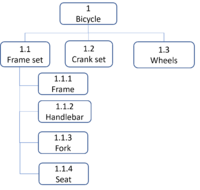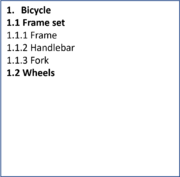Building Effective Work Breakdown Structures (WBS)
Developed by Luisa Fernanda Salazar Rivera s222401
"If you fail to plan, you are planning to fail" Benjamin Franklin
For successful project management, it is essential to have a comprehensive and detailed plan.[1] A project manager is mainly responsible for planning, integrating, and executing these plans. Structured planning is crucial given the relatively short duration and limited resources of projects. Without proper planning, projects, and programs can face adverse consequences such as unclear requirements at the project's onset, unrealistic expectations, and chaos.[2]
Effective project planning is necessary to prevent the negative outcomes of inadequate planning. There are three main reasons for project planning: to minimize or eradicate uncertainty, to gain a better understanding of the objectives, and to establish a basis for monitoring progress. The first significant step in the planning process, after defining the project requirements, is to develop the Work Breakdown Structure (WBS). The WBS provides a universal framework for describing the project as a sum of decomposed components. It is often used as a foundation for scheduling, budgeting, and monitoring processes, making it an essential tool for effective project, program, and portfolio management.[2]
Given all the benefits of building an effective WBS, the objective of this article is to serve as a guide for project managers in:
- Understanding the purpose and importance of creating a WBS.
- Identifying the key characteristics and components of a WBS.
- Developing effective WBS.
- Evaluating the quality and completeness of a WBS.
The sections of the article are organized to address these objectives, beginning with an overview of the WBS, followed by a discussion of its key characteristics and components. It then delves into the process of creating an effective WBS, including tips and best practices, and concludes with guidance on how to evaluate the quality and completeness of a WBS. This structured approach aims to provide project managers with a comprehensive guide to creating and utilizing a WBS in their projects, programs, and portfolios.
Contents |
Introduction
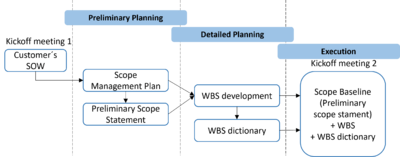
To understand when the development of a Work Breakdown Structure (WBS) can begin, it's important to have an overview of the typical phases involved when launching a project, as depicted in Figure 1. During kick-off meeting 1, the Statement of Work (SOW) is developed, which provides information about the customer's requirements and expectations for the project. In the preliminary planning phase, the Scope Management Plan is defined, which describes how the project scope will be developed, monitored, controlled, and verified, and serves as the basis for the Preliminary Scope Statement. This document confirms that the project scope aligns with the SOW provided by the customer. In the detailed planning phase, the WBS and WBS dictionary are developed, which will be the focus of this article. Finally, during the kick-off meeting 2, the parties agree on the Scope Baseline which includes the Preliminary Scope Statement, the WBS, and WBS dictionary.[1] [2]
Understanding the key elements related to project launching is essential to comprehending the subsequent sections focused on detailed planning, which include the WBS and WBS dictionary.
Overview of the WBS
What is a WBS
A WBS, as defined in the PMBOK Guide - Seventh Edition, is “A deliverable-oriented hierarchical decomposition of the total scope of work to be carried out by the project team to accomplish the project objectives and create the required deliverables”.[1]
Core characteristics
Based on the definition of a WBS provided in Section 2.1 the following characteristics should be highlighted:[1] [3]
- The deliverable orientation indicates the definition of specific project outcomes.
- The hierarchical representation of a WBS illustrates the parent-child relationships between each descending level, with each level providing a more detailed definition of the work.
- The decomposition nature indicates that a WBS translates the entire project scope into smaller components called work packages as will be further described in Section 3.2. The 100% rule is related to this core characteristic of the WBS. This rule states that the WBS should contain 100% of the work defined in the project scope and include all the required deliverables that should be completed. This rule is applicable to all levels within the hierarchy in terms of having 100% of the activities defined at the "child" level to deliver the work presented by the "parent" level.
Purpose of creating a WBS
The purpose of having a WBS is to assist project managers and stakeholders in developing a clear vision of the project’s outcome. It provides a visual representation of all the deliverables across the project life cycle. Additionally, the WBS assists in the planning process by defining work packages that are more manageable pieces of work that can easily be scheduled, cost estimated, monitored, controlled, and communicated.[1]
Why is it essential
A well-defined WBS will aid in having a commonly accepted scope definition between all project functions and stakeholders. If this is not properly aligned, there are high chances of having inadequate and inaccurate project deliverables. Furthermore, these deliverables will prevent having a good understanding with stakeholders and a good decision-making process, and will ultimately result in not achieving the project objectives. Therefore, it is essential to align expectations and have a common understanding of the project scope among all members and stakeholders.[1] [4]
Types and components of a WBS
Styles to present a WBS
The way project managers present the WBS can vary according to the organization's needs and how the WBS will be used. There are three main representations as shown in Table 1. It should be noted that Table 1 only introduces the most common representation styles. However, it is not a comprehensive WBS:[1] [5]
- Hierarchical: This is the most common representation of a WBS. Each box connects the child to the parent element in this structure. The most common version places the project at the top level and explicitly displays the hierarchical decomposition into smaller elements.
- Outline: In this style, the WBS is presented as a list. Each level displays an alphanumeric outline code or numbering scheme and the component.
- Tabular: Another representation is the tabular style. The columns in the table represent the hierarchical structure and each row has an alphanumeric outline code or numbering scheme and the component as in the outline style.
| Hierarchical | Outline | Tabular |
|---|---|---|
Types of decomposition for a WBS
A WBS can be constructed using different types of breakdowns such as deliverable-oriented, phase-oriented, and product-oriented decompositions, among others. Usually, a combination of these decomposition methods is employed to ensure an effective WBS. The following, are examples of the elements that could be included in each type of decomposition:[1] [5]
- Deliverable-oriented WBS: This method divides the project into deliverables or outputs. Examples of elements could be manuals, prototypes, or software modules.
- Phase-oriented WBS: This method divides the project into individual stages. Examples of elements could be planning, design, testing, and development.
- Product-oriented WBS: This method divides the project into individual product components. Examples of elements include suspension, brakes, electrical system, and interior.
Main WBS components
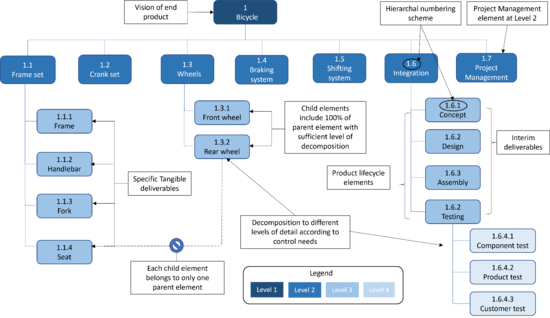
The focus of this section is to explain the main WBS components. This example was taken from the Practice Standard for Work Breakdown Structures by the Project Management Institute (PMI). Figure 2 was selected for simplicity in illustrating the product, and the intention is to allow the reader to focus on the WBS and its essential components.[1] [5] The main components of a WBS will be explained using Figure 2 as a reference:
- Levels and WBS IDS:
Level 1: Regardless of the type of decomposition or the style of the WBS, the first level always represents the name of the project, product, or initiative. This level includes the entire scope of work necessary to produce the product, service, or outcome of the project designated by the number 1. In Figure 2, the “bicycle” represents the product of the project.
Level 2: This is the first level of decomposition for the project which provides a high-level view of the scope of the project. The numbering in the second level is 1.1, 1.2, 1.3,…., 1,n. In the example of the bicycle, the second level represents all the components required to deliver the final product.
Level 3 and below: These levels further decompose the deliverables from Level 2. These levels correspond to only one parent in level 2 and the numbering is: 1.1.1, 1.1.2, 1.1.3, …, 1.1.n, 1.2.1, 1.2.2, 1.2.3, …, 1.2.n, according to the needs of the project.
- Work Packages:
As introduced in Section 1.1, a work package is defined as the lowest level in a WBS which represent tasks that can be assigned to a team member or department. For project managers, this level of detail will allow them to reliably estimate cost, and duration, and to monitor and control the work.[1] [5]
Building effective WBS
Preparation methods
There are different methods and tools available to create a WBS such as top-down and bottom-up development strategies, WBS organizational standards, WBS templates, brainstorming, expert assistance, and mind mapping, among others. The selected method depends on the project objectives, requirements, assumptions, and constraints.[5] This article will focus on explaining the top-down and bottom-up approaches as they are often referred to in the literature about WBS.
Top-down method
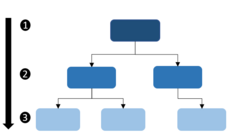
This is one of the most preferred methods when creating a WBS. An illustration of this method is provided in Figure 3, as can be seen, the decomposition process starts at the top of the WBS. In other words, you begin with the overall picture and continue breaking down the work into smaller, more manageable components.The following steps describe the general approach for developing a WBS following the top-down method:[1] [5]
Step 1: Identify all the final products, services, or outcomes the project will deliver. They are the level 2 components.
Step 2: Define major interim deliverables to accomplish each level 2 components.
Step 3: Break down each major deliverable to a level of detail that allows appropriate management and control. Following the 100% rule, the total of elements at each level represents 100% of the necessary work for the above element.
Step 4: Review and validate with key stakeholders until agreed that the project planning can be successfully completed and that the execution will produce the required deliverables and results.
Bottom-up method
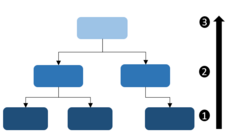
An illustration is provided in Figure 4, this method starts at the lowest level of deliverables – the work packages – and works upwards to the top level of the WBS. The following steps describe the general approach for developing a WBS following the bottom-up method:[1] [5]
Step 1: Identify all the work packages of the project (deliverables), each work package typically contains one deliverable.
Step 2: Group related work packages logically.
Step 3: Aggregate deliverables to the next parent level. Following the 100% rule, the sum of elements at each level represents 100% of the work required below it.
Step 4: Once a specific set of interconnected work packages has been consolidated into a parent element, re-examine the subset to ensure that all the work has been included.
Step 5: Repeat until all the work packages have been aggregated to a single parent, level 1 element of the WBS, and make sure that the completed structure encompasses the entire scope.
Step 6: Review and validate with key stakeholders until agreed that the project planning can be successfully completed and that the execution will produce the required deliverables and results.
Decomposing the project work
How to decompose the project work?

The decomposition technique is used when creating a WBS to break down the project. This is an iterative process that starts by identifying the best approach, according to Section 3.2, to decompose the major deliverables. Figure 5 shows the iterative nature of the work decomposition until all the work packages are identified. When breaking down the scope of the project, you should consider the question: Is this work package detailed enough to be effectively estimated and managed, or should it be broken down further for better comprehension and management?.[5]
When to stop decomposing the work?
Various guidelines for determining when to stop the decomposition process are based on the amount of time it takes to complete a work package.[5] An example of this rule is given by Dr. Harold Kerzner: "A typical work package might be 200–300 hours and approximately two weeks in duration".[2] A practical tip given by Liliana Buchtik is to decompose to the level of detail for which you are able to manage, assign the work, and estimate cost and time.[5]
WBS Dictionary
The WBS dictionary is a document that supports the WBS by providing comprehensive information for each element within it. The information in the WBS dictionary typically includes a detailed description of the work, deliverables, and milestones associated with each activity. The dictionary components can be used to drive scheduling, cost estimating, managing, and controlling work.[1]Table 2 provides a description of each component in the WBS dictionary and an example based on Figure 2.
| WBS Dictionary - Bicycle Project – Version 1.0 | ||
|---|---|---|
| WBS Dictionary component | WBS Dictionary description | Example |
| Level | Relative position in the decomposition | 3 |
| WBS Code | Unique identifier of the WBS element | 1.1.4 |
| WBS Element name | Label of the WBS element | Seat |
| Duration | Time to complete the task | 3 months |
| Start date and end date | Timeline of the task | 1-March-2023 to 1-June-2023 |
| Definition | Description of the work to be done | Design/Build/Test Bicycle Seat to Specifications |
| Assumptions and constraints |
Assumptions refer to accepted circumstances or conditions Constraints refer to limitations that impact the scope, schedule, or budget |
Assumption: Seat will be used under normal operating conditions Constraint: Weight not to exceed 18 oz. |
| Responsible individual, team, or organization |
Responsible individual, team, or organization accountable for completing the task |
Engineers (names) and project manager (name) |
| Schedule milestones* |
Significant events that mark important points in the timeline of the project |
Milestone 1: Design Complete 31-March-2023 Milestone 2: Build Complete 30-April-2023 Milestone 3: Test Complete 31-May-2023 |
| Cost estimate* | Estimated cost of the resources required to complete the task or activity | |
(*)Some of the methods recommended by the PMI for estimating work, time, or cost in a project include expert judgment, analogous estimating, parametric estimating, and multipoint estimating. However, those topics will not be covered in this article.[6]
Steps for building an effective WBS
The following steps are presented as a guide for building a valuable WBS:[5]
Step 1: Obtain inputs. Including the Scope Management Plan and the Preliminary Scope Statement.
Step 2: Define the team. Including relevant stakeholders, team members, experts, colleagues, and project sponsors.
Step 3: Analyze the scope. Identify and analyze the work required to accomplish the scope of the project.
Step 4: Determine the decomposition approach. Either deliverable-oriented, phase-oriented, or product-oriented as described in Section 3.2.
Step 5: Determine the representation style such as hierarchical, outline, or tabular as described in Section 3.1.
Step 6: Determine the software to create the WBS. Popular useful tools include WBS Schedule PRO, Trello, and Asana.
Step 7: Determine the preparation method approach and apply the decomposition technique. As outlined in Section 4.1 select the preparation method, either top-down or bottom-up, and follow the corresponding steps. Then, apply the decomposition technique diagram presented in Figure 5.
Step 8: Apply the 100% rule to verify that all the required work is included and ensure no duplicates or overlaps in work.
Step 9: Check the level of decomposition. Verify that the work packages are decomposed to an appropriate level. Section 4.2.2 addressed when you should stop decomposing.
Step 10: Assign WBS IDS. Assign a WBS to each component following the description presented in Section 3.3.
Step 11: Insert level legend. If the levels have been identified with color, as depicted in Figure 2, use a legend to identify each level.
Step 12: Obtain stakeholder input. Engage in a dialogue with your project team and stakeholders to initiate a series of updates and modifications until reaching an agreement with all the relevant stakeholders.
Step 13: Create a WBS dictionary as presented in Section 4.3 simultaneously with step 12.
Step 14: Obtain approval and communicate. After approval, if changes are necessary, go through the formal change control process. Present the finished WBS and WBS dictionary to the project team and stakeholders.
Step 15: Generate the scope baseline. As presented in Figure 1, with the project scope statement, the WBS, and the WBS dictionary, the scope baseline can be generated. Going forward, any request for changes to the scope should be assessed against the scope baseline.
Evaluating the quality of a WBS
The PMI Practice Standard for WBS defines core quality characteristics that a WBS must fulfill to be considered of high quality. "A quality WBS is a WBS constructed in such a way that it satisfies all of the requirements for its use in a project".[5] [7]There are two sub-principles associated:
WBS Quality Sub-Principle 1: Core Characteristics
This sub-principle comprises a set of characteristics that are crucial for creating a valuable WBS. These characteristics include being deliverable-oriented, defining the scope of the project, clarifying and communicating the work to stakeholders, following the 100% rule, capturing all the deliverables, being a hierarchical structure represented in a graphical, outline, or tabular style, using nouns to define elements, having a numbering scheme that aids in identifying its hierarchical nature, and being created by those performing the project in collaboration with stakeholders and experts. The WBS should also iteratively evolve with the progressive elaboration of the project scope until the scope has been baselined.[7]
The second sub-principle, use-related characteristics, focuses on creating a WBS with characteristics unique to a specific project, such as decomposing the WBS to an appropriate level, providing detailed information for communicating all the work, allowing monitoring and controlling activities, enabling assignment for accountability, and having a clear and organized structure that meets the project management requirements. These characteristics may differ from one WBS to another and intend to be used for purposes unique to a specific project.[7]
Limitations
The WBS is a highly effective tool that can assist project managers in breaking down the entire scope of a project into smaller, more manageable components, which are easier to control and monitor. Additionally, it provides the basis for cost and time estimation and communication with stakeholders. However, this tool also has limitations and disadvantages including:[2]
- Time-consuming: Developing a detailed WBS might be time-consuming, particularly for large projects.
- Inflexibility: Once the WBS is finished and the program has started, it becomes a costly procedure to add, remove, or change activities. This might represent a significant disadvantage for projects with a high level of uncertainty.
- Difficulties in breaking down the scope: If the structure does not contain enough levels, the integration of the activities can be difficult. On the other hand, if too many levels exist, then it might be challenging and unproductive to monitor all the work packages.
Annotated Bibliography
Kerzner, H. (2009) Project Management: A Systems Approach to Planning, Scheduling, and Controlling. (10th Ed.). New Jersey: John Wiley & Sons, Inc. The book provides practical and theoretical insights into the various phases of project planning and management, including the use of the WBS. It is an essential reference for anyone interested in developing their skills in project management. The book's systems approach is particularly useful for those who want to understand how all aspects of a project fit together and how to manage them effectively. Kerzner's writing style is clear and concise, making the book accessible to both novice and experienced project managers alike.
Project Management Institute, Inc. (PMI). (2019). Practice Standard for Work Breakdown Structures (3rd Ed.). Newtown Square, PA: Project Management Institute. The PMI standard is a comprehensive guide for project managers seeking to understand the concepts, principles, and characteristics of a WBS. The practice standard, provides explanations, specifications, and detailed information about the development and implementation of a WBS in different project life cycles such as waterfall, iterative, incremental, and agile. Additionally, the standard includes examples of how a WBS could be used to estimate resources, project duration, and cost. The book is well-organized, clearly written, and includes helpful examples to illustrate the key concepts and principles.
Bucktik, L. (2010). Secrets to Mastering the WBS in Real-World Projects: The Most Practical Approach to Work Breakdown Structures (Wbs)! (2nd Ed.). Newtown Square, PA: Project Management Institute. This book is a valuable resource for project managers seeking to enhance their understanding of the WBS and its application in various project environments. Chapter 7 is dedicated to discussing software tools that can assist with creating and maintaining the WBS. This chapter provides an overview of various software tools available in the market, their features, and how they can be used. The author offers practical advice on how to choose the right software tool for the project and provides tips for integrating the WBS with other project management tools.
Additionally, the following wiki articles delve into scheduling and cost techniques that were not covered in this article:
- Scheduling techniques in Project Management. . This article introduces the following scheduling techniques: PERT, CPM, and Gantt.
- Cost Estimation Techniques for Projects. .Among other cost estimation techniques, this article presents expert judgment, analogous estimate, and parametric estimate.
References
- ↑ 1.00 1.01 1.02 1.03 1.04 1.05 1.06 1.07 1.08 1.09 1.10 1.11 1.12 1.13 1.14 Project Management Institute, Inc. (PMI)., "Practice Standard for Work Breakdown Structures (3rd Ed.)", 2019
- ↑ 2.0 2.1 2.2 2.3 2.4 2.5 Kerzner, H. ., "Project Management: A Systems Approach to Planning, Scheduling, and Controlling. (7th Ed.) ", 2009
- ↑ Norman, E; Brotherton, S; Fried, R. "Work Breakdown Structures: The Foundation for Project Management Excellence. ", 2008
- ↑ Cicala, G. "The Project Managers Guide to Microsoft Project 2019: Covers Standard, Professional, Server, Project Web App, and Office 365 Version", 2019
- ↑ 5.00 5.01 5.02 5.03 5.04 5.05 5.06 5.07 5.08 5.09 5.10 5.11 5.12 5.13 5.14 5.15 Bucktik, L."Secrets to Mastering the WBS in Real-World Projects: The Most Practical Approach to Work Breakdown Structures (WBS)! (2nd Ed.) PMI ", 2010
- ↑ Project Management Institute, Inc. (PMI)., "Project Management: A guide to the Project Management Body of Knowledge-PMBOK Guide (7th Ed.)", 2021
- ↑ 7.0 7.1 7.2 Project Management Institute, Inc. (PMI)., "Practice Standard for Work Breakdown Structures (2nd Ed.)", 2013
